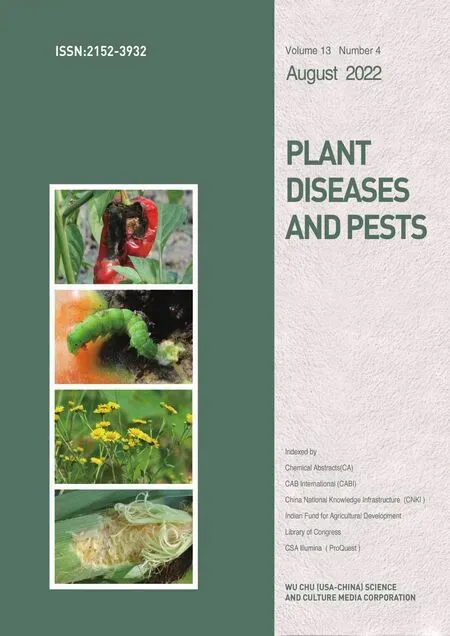Life History and Control Measures of Dendrolimus sibiricus Tschetw. in Northeast China
Jinbo LIU
Benxi Forestry and Grassland Pest Control and Quarantine Workstation, Benxi 117000, China
Abstract In this paper, the life history of Dendrolimus sibiricus Tschetw. is studied, and the effective measures against the pest such as prediction, resource protection, biological control, light trapping and chemical control are put forward. The results will provide the basis for scientific control.
Key words Larix gmelinii; Dendrolimus sibiricus; Control measures
1 Introduction
In addition to seed and nursery pests, there are a variety of pests that threaten the growth ofLarixgmeliniiin different environments and at different stages of tree development. The impact of pests is more significant in large-areaL.gmeliniiartificial forest, and it has become a barrier in the artificial regeneration ofL.gmelinii. Under the forestry policy with artificial renewal, the appearance of forest area is changing rapidly. The species and composition of insects will change accordingly. Along with the growth ofL.gmeliniiartificial forest, in addition to historic pests such asDendrolimussibiricusTschetw., which seriously infect both adult and young forests, and pests that can be transported with seedlings and seeds, some local but not major pests may become primary pests due to environmental changes and improper management, while other major pests lurking in the local area may get opportunities to become rampant.
D.sibiricus, belonging to Lasiocampidae, Lepidoptera, is the No.1 pest in China’s forest, and is distributed in the north of Danshen line in northeast China. It is harmful toL.gmelinii,Pinuskoraiensis,P.sylvestris,Piceaasperata,etc., and seriously damages both adult and young forests.
2 Morphological characteristics of insects
D.sibiricusadults have a clear white spot in the median cell and 3 dark horizontal lines on the forewings. The last two spots on submedian and sunouter line are perpendicular to each other. Wing span: male moth 57-72 mm, female moth 69-85 mm. Eggs oval, light green. Larvae sootyblack, hairchested and hairy, dorsal hair black, thinner, lateral hair silvery white, dense. There are 2 dense velvet dark blue hair bands on the thorax, and dark blue long hair bundles on the dorsal surface of the 8thventral segment. Pupae brown, cocoon grey.
3 Life history
D.sibiricusoccurs a generation every year in Liaoning Province, China. The adults emerge in July and August each year, mate and lay eggs. The larvae hatch in August.D.sibiricussurvives the winter as the 4thinstar larvae under the tree in September and October. In April and May of the following year, when the average temperature of the day exceeds 10 ℃, they begin to move and climb up to the tree for feeding. The 7thinstar larvae cocoon and pupate on crown in mid-June. In Changbai Mountain and Xiaoxing’anling forest region, there are mixed occurrence ofD.sibiricuswith one generation a year (straddle over 2 years) and one generation 2 years (straddle over 3 years). The instar duration ofD.sibiricuswith one generation a year is short, and there are more instars ofD.sibiricuswith one generation 2 years. In general, when the daily average temperature reaches about 10 ℃ from late April to early May, the overwintering larvae begin to move and climb up to the tree for feeding. After late September, when the average daily temperature drops to 3-8 ℃, the larvae will overwinter under trees. The instars of overwintering larvae are very inconsistent. The 3rdand 4thinstars of larvae remain larval state in the next year until September, and then enter the second overwintering as the 7thinstar larvae. The other 4thand 5thinstar larvae will cocoon as the 6thand 7thinstar larvae in July, pupate and then emerge to adults. Eggs are laid on branches and leaves in blocks. A female moth can lay 300-400 eggs, which will hatch in about 10 d, and go through the winter under trees in October and November when the temperature is cold.
D.sibiricusoccurs in the warm and well-drained pureL.gmeliniiartificial forest on the hillside, and there are clear cycles of rampant activity. Combined with many years of practice, the factors that can extinct rampancy are basically under control, but the factors that contribute to the rampancy of this pest is not well understood. It is generally believed that after more than 2 consecutive years of warm and dry weather, the pest will be rampant.
4 Prevention and control measures
4.1 ForecastIn order to prevent and control the serious damage ofD.sibiricus, related personnel should start with monitoring and reporting work, set up monitoring and reporting stations in key areas, and establish pest records. Only by doing a good job in forecasting can nip in the bud, especially in drought years, the density of pests should be regularly investigated to prepare for pest prevention and control.
4.2 Resources protectionMixed forest is established, and overcutting and grazing are prohibited, in order to prevent the destruction of forest form.
4.3 Biological controlThere are many natural enemies ofD.sibiricus, especially in the artificial forest. The protection and utilization of natural enemies should be strengthened, especially to protect beneficial birds and to utilize parasitoids such asTrichogrammaspp. andTelenomusspp.
4.4 Artificial controlThe masses are mobilized to pick cocoons and eggs, and the collected cocoons and eggs are put in iron cages to protect natural enemies.
4.5 Light trapBlack lights are installed to trap newly emerged adults.
4.6 Chemical controlInsecticides and bacterial agents are used to eliminate the newly hatched larvae. The commonly used agents include matrine, beta-cypermethrin, 6% benzene hexachloride WP 200-500 times dilution, 90% trichlorfon 6 000 times dilution, malathion 250 times dilution, as well as benzene hexachloride FU, insecticidal bacteria "qingchongjun",etc.In the spring of the following year, the overwintering larvae are controlled and mopped up.
- 植物病虫害研究(英文版)的其它文章
- Demonstration and Promotion of Integrated Management Technology of Wheat Sheath Blight and Wheat Crown Rot in Zibo City
- Status Analysis of Recycling and Disposal of Pesticide Packaging Waste in Western Zhejiang
- Identification and Control of Several Leaf Diseases of Poplar
- Control Measures against Main Pinus koraiensis Diseases in Liaoning Province
- Effects of Different Fertilization Measures on Chemical Composition and Quality of Flue-cured Tobacco
- Prevention and Control Test of Semiaphis heraclei in Spring

